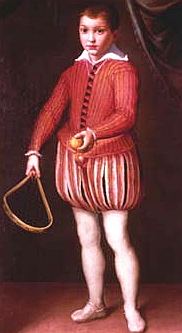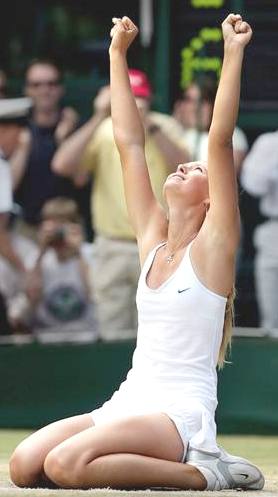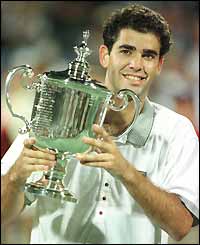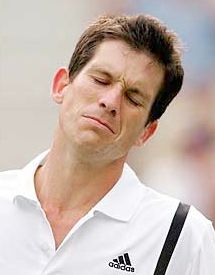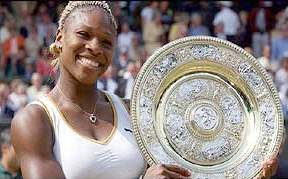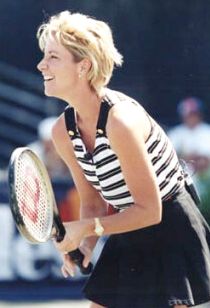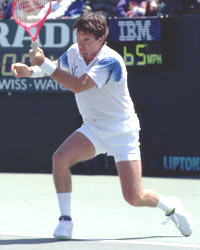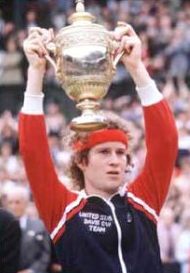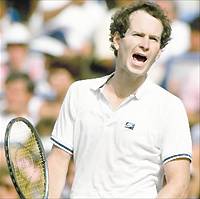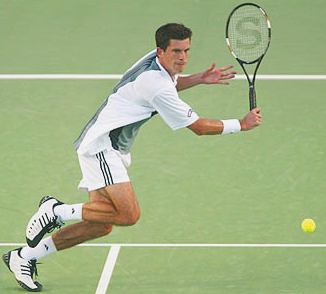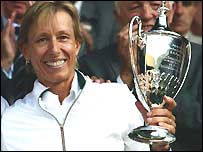|
TENNIS
|
||
|
Tennis is a game played indoors or outdoors by two players (singles) or four players (doubles) on a level court, which may be of grass, tarmac or manmade surfaces. The object of the game is to hit a rubber inflated ball into your opponents court, over a net of a fixed height, such that your opponent fails to return the ball.
The game of tennis is the same everywhere in principle. The name given to the game differs in different countries. In Great Britain it is called Tennis or, to distinguish it from Lawn Tennis, Real Tennis or Royal Tennis. In the USA it is called Court Tennis: in France Jeu de Paume (hand ball): and in Australia Royal Tennis. The various names throw light on the development of the game. Tennis was played in 5th century Tuscany when villagers used to strike balls up and down the streets with bare hands.
The Cremona 1570
How it all began
Some people believe that that the ancient Egyptians, Greeks, and Romans played different versions of tennis. Drawings and descriptions of any tennis-like games have not been discovered, but a few Arabic words dating from ancient Egyptian times are cited as evidence. The theory goes that the name tennis derives from the Egyptian town of Tinnis alongside the Nile and the word racquet evolved from the Arabic word for palm of the hand, rahat.
Aside from these two words, evidence for any form of tennis preceding the year 1000 is lacking, and most historians credit the first origins of the game to 11th or 12th century French monks, who began playing a crude handball against their monastery walls or over a rope strung across a courtyard. The game took on the name jeu de paume, which means "game of the hand." Many who dispute more ancient origins argue that tennis derived from the French tenez, which meant something to the effect of "take this," said as one player would serve to the other.
As the game became more popular, courtyard playing areas began to be modified into indoor courts, where the ball was still played off the walls. After bare hands were found too uncomfortable, players began using a glove, then either a glove with webbing between the fingers or a solid paddle, followed by webbing attached to a handle--essentially a racquet. Rubber balls were still centuries away, so the ball was a wad of hair, wool, or cork wrapped in string and cloth or leather, then in later years, hand-stitched in felt to look something like a modern baseball.
The nobility learned the game from the monks, and some accounts report as many as 1800 courts in France by the 13th century. The game became such a popular diversion, both the Pope and Louis IV tried unsuccessfully to ban it. It soon spread to England, where both Henry VII and Henry VIII were avid players who promoted the building of more courts.
By the year 1500, a wooden frame racquet strung with sheep gut was in common use, as was a cork-cored ball weighing around three ounces. The early tennis courts were quite different from the modern "lawn tennis" court most of us are used to. The early game matured into what is now called "real tennis," and England's Hampton Court, built in 1625, is still used today. Only a handful of such courts remain. It's a narrow, indoor court where the ball is played off walls that include a number of openings and oddly angled surfaces toward which the players aim for various strategic purposes. The net is five feet high on the ends, but three feet in the middle, creating a pronounced droop.
Maria Sharapova
The game's popularity dwindled almost to zero during the 1700s, but in 1850, Charles Goodyear invented a vulcanization process for rubber, and during the 1850s, players began to experiment with using the bouncier rubber balls outdoors on grass. An outdoor game was, of course, completely different from an indoor game played off walls, so several new sets of rules were formulated.
LAWN TENNIS ORIGINS
Unlike most other sports, lawn tennis has precise origins. An Englishman, Major Walter C. Wingfield, invented lawn tennis (1873) and first played it at a garden party in Wales. Called “Sphairistiké” [Gr.,=ball playing] by its inventor, the early game was played on an hourglass-shaped court, widest at the baselines and narrowest at the net. In creating the new sport, Wingfield borrowed heavily from the older games of court tennis and squash racquets and probably even from the Indian game of badminton.
In 1874, Major Wingfield patented in London the equipment and rules for a game fairly similar to modern tennis. In the same year, the first courts appeared in the United States. By the following year, equipment sets had been sold for use in Russia, India, Canada, and China.
Croquet was highly popular at this time, and the smooth croquet courts proved readily adaptable for tennis. Wingfield's original court had the shape of an hourglass, narrowest at the net, and it was shorter than the modern court. His rules were subjected to considerable criticism, and he revised them in 1875, but he soon left the further development of the game to others.
In 1877, the All England Club held the first Wimbledon tournament, and its tournament committee came up with a rectangular court and a set of rules that are essentially the game we know today. The net was still five feet high at the sides, a carryover from the game's indoor ancestor, and the service boxes were 26 feet deep, but by 1882, the specifications had evolved to their current form.
COURT TENNIS
Court tennis is also known as royal tennis. It originated in France during the Middle Ages and became a favorite of British royalty, including Henry VIII. The progression from court tennis, which used an unresilient sheepskin ball filled with sawdust, sand, or wool, to lawn tennis depended upon invention of a ball that would bounce. Lawn tennis caught on quickly in Great Britain, and soon the All England Croquet Club at Wimbledon held the first world tennis championship (1877). Restricted to male players, that event became the famous Wimbledon Tournament for the British National Championship, still the most prestigious event in tennis. In 1884 Wimbledon inaugurated a women's championship. Soon the game became popular in many parts of the British Empire, especially in Australia.
Tennis spread to the United States by way of Bermuda. While vacationing there, Mary Ewing Outerbridge of New York was introduced (1874) to the game by a friend of Wingfield. She returned to the United States with a net, balls, and rackets, and with the help of her brother, set up a tennis court in Staten Island, N.Y. The first National Championship, for men only, was held (1881) at Newport, R.I. A women's championship was begun six years later, and in 1915 the National Championship moved to Forest Hills, N.Y. Since 1978 the National Tennis Center in Flushing, N.Y., has hosted the event (known as the U.S. Open). The Tennis Hall of Fame is in Newport, R.I.
In Great Britain, as in France, royal patronage ensured the continued
popularity of the game. French Kings in the 16th century and Stuart
Kings in the 17th century were enthusiastic players. George IV
(1763-1830), Prince Albert (1819-1861) - there is a locker in the
changing room at Hampton Court Palace which still bears his name -
Edward VII (1842-1910) and George V (1866-1936) have all supported the
game.
Pete Sampras
Rules and Equipment
Lawn tennis was originally played on grass courts, but most major events are now played on courts of hard, composite materials; exceptions include Wimbledon, played on grass, and the French Open, played on clay. In singles play the court measures 78 ft by 27 ft (23.8 m by 8.2 m). The court is divided in half by a net 3 ft (91 cm) high in the middle and 3.5 ft (1.1 m) high at the end posts. On either side of the net lie the forecourts, each of which contains two adjacent service courts measuring 21 ft by 13.5 ft (6.4 m by 4.1 m) each. A backcourt 18 ft (5.5 m) long adjoins each forecourt. A base line that runs parallel to the net terminates the playing court. In doubles play, 4 1/2-foot-wide (1.4-m) alleys flanking either side of the court perpendicular to the net are also in play.
Play is directed toward hitting the inflated rubber, felt-covered, unstitched ball (slightly smaller than a baseball) with a racket—oval headed, originally 27 in. (68.58 cm) long but now usually longer, the hitting surface strung with resilient fiber—into the opponent's court so that it may not be returned. One player serves an entire game and is given two service tries each time the ball is put in play. The ball is served diagonally from behind the base line so that it bounces beyond the net, in the opposite service court. A let ball (one that caroms off the top of the net into the proper service court) does not count as a fault (bad serve). Service alternates after points, between the right- and left-hand courts. After the first game and all odd-numbered games, the players change ends of the court.
Tim Henman
Once the serve puts the ball in play, players may hit it into any part of the opponent's court until a point is scored. Rallies won by either player score points. Scoring progresses from love (zero) to 15 (first point), to 30, then 40. The point scored after 40 wins the game, but when the game goes to deuce (tied at 40–40) a player must go two points ahead to win it. The first player to win six games takes the set, provided the opposing player has won no more than four games.
Traditionally, after the players were tied at five games all, the first to go two games ahead won the set. In 1970, however, the United States Lawn Tennis Association (founded 1881 and now simply the United States Tennis Association), the sport's national governing body, initiated an abbreviated method, called the tie-breaker, for deciding deadlocked sets. In a tie-breaker, the first player to win seven points wins the set, provided the opponent trails by at least two points. Only in the deciding set of major championship matches outside the United States is the original two-game margin of victory retained.
The best two out of three sets wins most professional matches; the best three out of five sets wins a late-round match in men's play in major championships. An umpire calls play, and in important matches a net judge, foot-fault judges, and linesmen often assist.
Serena Williams 2002
The Professionalization of Tournament Tennis
In 1900 the international team competition known as the Davis Cup tournament began. Along with the Wightman Cup (begun 1923), an annual tournament between British and American women's teams, the Davis Cup helped to focus international attention on tennis. In 1963, a women's Davis Cup equivalent, the Federation Cup, usurped the prestige of the Wightman Cup. In the first decades of the 1900s tennis was primarily a sport of the country club set. The widespread construction of courts on school and community playgrounds in the 1930s (many built by the federal government's New Deal agencies) helped to make tennis more accessible to the public.
When the professional game showed itself to be profitable in the late 1920s, a number of amateur players joined the tour. One of the first to do so was William Tilden, perhaps the greatest player in the history of tennis. Before Tilden turned pro (1931), he won a total of seven United States singles championships and three Wimbledon championships.
The continued defection of amateur players into the professional ranks was one of the factors that led amateur tennis's world governing body, the International Lawn Tennis Federation (ILTF, founded 1913), to open its tournaments to both professionals and amateurs in 1968. For many years the major ILTF-sponsored tournaments, including Wimbledon and the U.S. National Championship, had been restricted to amateurs. With the advent of open tennis, however, the great professionals were allowed to compete for the major titles. Eventually, the Davis Cup also allowed professionals.
Chris Evert
The four major annual tournaments in international tennis are Wimbledon, the Australian Open, the French Open, and the U.S. Open. Winning all four in the same year is called a grand slam. Only Don Budge (1938), Rod Laver (1962, 1969), Maureen Connolly (1953), Margaret Court (1970), and Steffi Graf (1988) have won grand slams. In 1971, the establishment of a women-only professional tour gave female pros financial parity with their male counterparts. In the same year Billie Jean King became the first woman athlete in any sport to earn more than $100,000 in one year. In the 1970s a team league, World Team Tennis, operated for several years, but was unsuccessful. The professional tour remains the most visible focus for the sport, its major tournaments surpassing in prestige even competition in the Olympics, which added tennis in 1988.
LINKS:
WIMBLEDON LEGENDS
Jimmy Connors
DOWN THE DECADES
ROLL OF HONOUR
John McEnroe Being serious
CLASSIC MATCHES
Martina Navratilova
A - Z SPORTS INDEX
A taste for adventure capitalists
Solar Cola - a healthier alternative
|
||
|
This website is Copyright © 1999 & 2020. The bird logos and name Solar Navigator are trademarks. All rights reserved. All other trademarks are hereby acknowledged. Max Energy Limited is an educational charity. |
